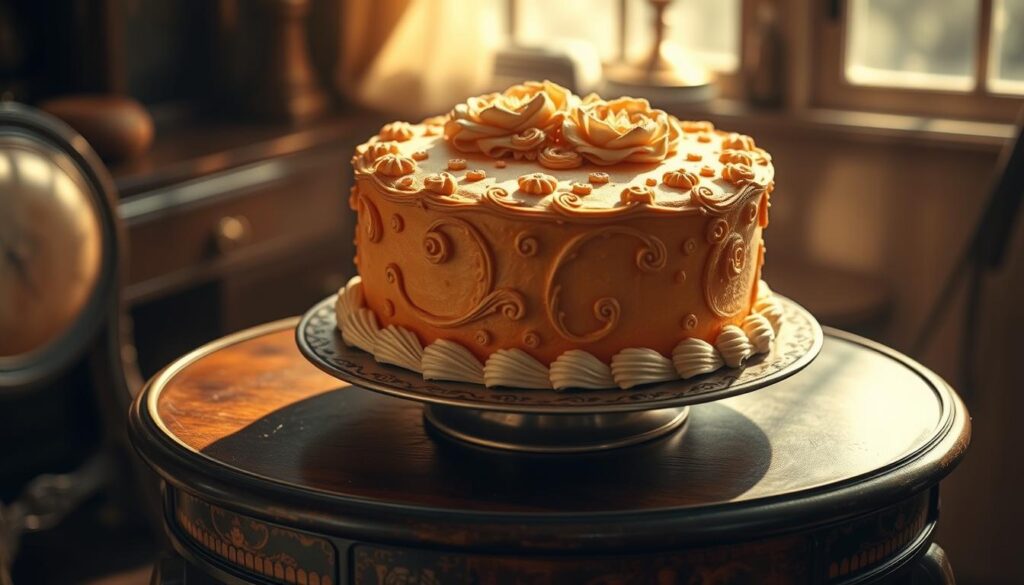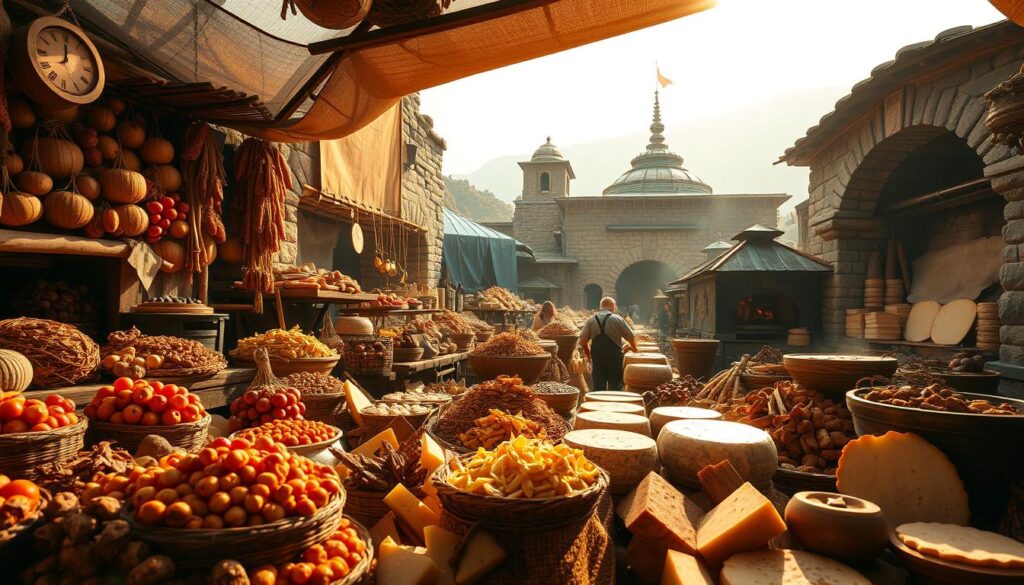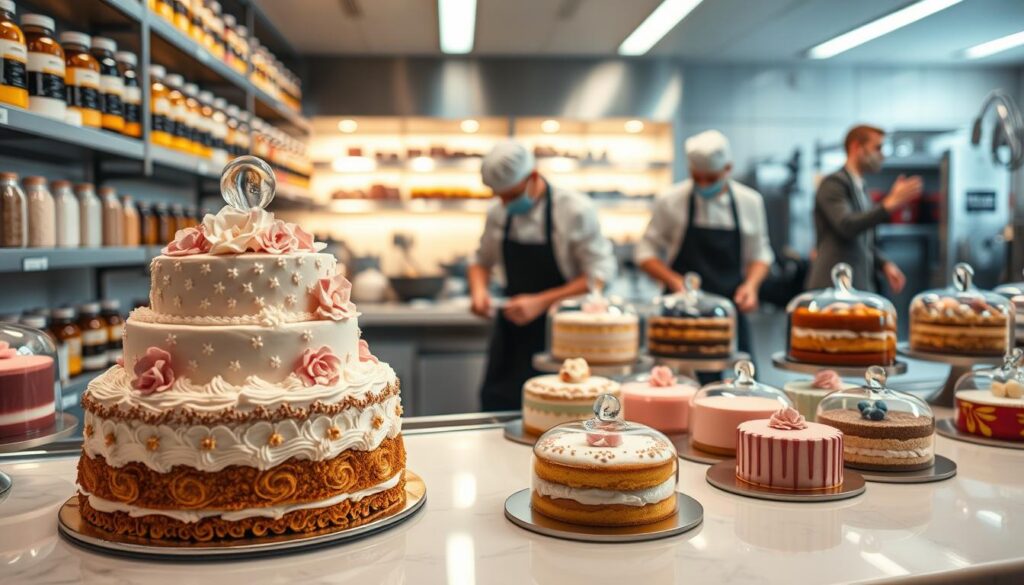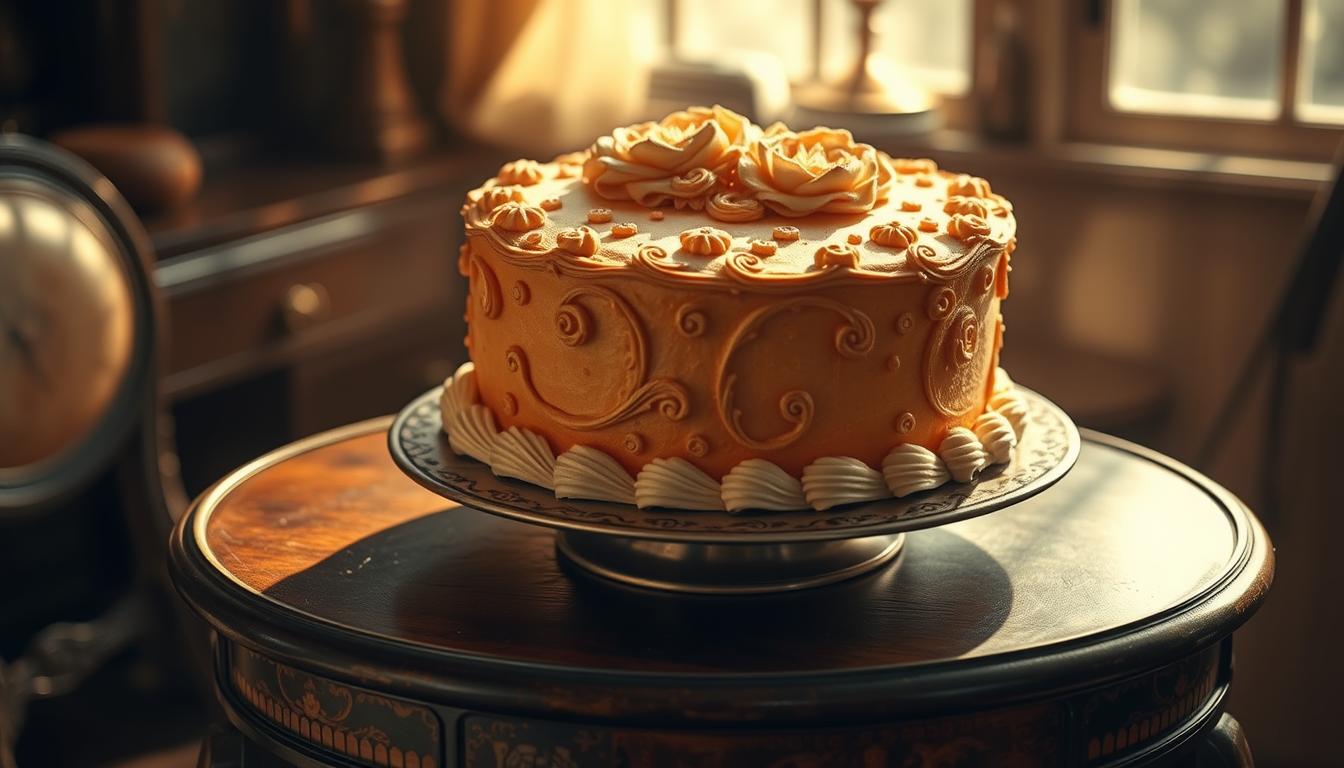Imagine cutting into a cake that was baked when your great-grandparents were young. This isn’t just a dream—the 100-year cake is real! These cakes last for decades, keeping their shape and taste. They come from all over the world, like fruitcakes passed down through families or special wedding cake slices.

So, how do these cakes stay fresh when others spoil? It’s all about the ingredients and how they’re preserved. Food scientists are still learning about these secrets. These cakes are more than just treats—they’re a link to our past, shared through the love of sweets.
Exploring these long-lasting desserts gives us a glimpse into baking’s past. Today, bakers are bringing back these old techniques. From ancient recipes to treasures in museums, the tradition of these cakes continues to amaze everyone.
Key Takeaways
- Century cakes can remain intact for decades with proper preservation techniques
- Traditional time-defying confections use specific ingredients that resist spoilage
- Many families preserve wedding cake slices as heirlooms for generations
- Food scientists study 100-year cakes to understand preservation mechanisms
- Historical examples of century cakes can be found in museums worldwide
- Modern bakers are reviving traditional preservation methods for long-lasting desserts
The Extraordinary Tale of a Century-Lasting Dessert
Imagine cutting into a cake baked when your great-grandparents were children. This is a culinary achievement that seems impossible. It shows humanity’s skill in preserving food for centuries.
Origins of the Time-Defying Confection
Early time-defying confections came from need, not just for fun. They were made for soldiers and sailors on long trips. Fruit cakes, with alcohol and dried fruits, were made to last long without refrigeration.
First Documented Cases of Ultra-Preserved Cakes
The first ultra-preserved cakes were documented in the Victorian era. Fidelia Ford started a tradition in 1869 of baking fruit cakes to age for years. One cake from 1878 lasted 125 years until 2003.
Stories like this are found worldwide. Wedding cakes were kept as family treasures, not eaten at celebrations.
| Notable Ultra-Preserved Cake | Origin Year | Preservation Method |
|---|---|---|
| Michigan Fruit Cake | 1878 | Alcohol wrapping, cool storage |
| Antarctic Expedition Cake | 1910 | Natural freezing, airtight container |
| Royal Wedding Fruitcake | 1923 | Brandy soaking, sealed tin |
The Cultural Phenomenon Behind Long-Lasting Desserts
Long-lasting desserts are more than just food. They symbolize tradition, family, and culture. In England, Christmas puddings are aged for months or years.
In Japan, wagashi sweets are made to last for special events. These desserts are not just food. They connect families across generations.
What Exactly Is a Cake That Lasts for a Hundred Years?
A cake that lasts for a hundred years is not your typical birthday treat. These amazing desserts are the result of advanced food preservation. They use special ingredients and methods to stay fresh for decades or even centuries.
Unlike regular cakes, these last-longer cakes have very little moisture. They go through special drying processes. They also have lots of sugar or alcohol and natural preservatives like honey or dried fruits.
These ingredients help keep bacteria and mold away. This makes the cakes last much longer.
The oldest edible cake was discovered in an Egyptian tomb, estimated to be over 4,000 years old yet remarkably intact – the ultimate extended shelf-life dessert.
Many think these century-lasting desserts are not edible. But, surprisingly, some can still be eaten. Their texture and taste change a lot over time. But they don’t rot like regular food.
They get harder and crystallize instead. This keeps them in good shape for a long time.
The difference between these cakes and modern foods is clear. These historical desserts use natural ways to preserve them. Their long life comes from the right mix of ingredients and how they’re stored.
The Science Behind Extreme Cake Preservation
The secret to century-lasting cakes isn’t magic. It’s a mix of chemistry, microbiology, and cooking knowledge. These cakes stay fresh because they have conditions that stop bacteria and slow down decay.
Key Ingredients That Enable Longevity
Extreme cake preservation starts with special ingredients. High-proof alcohol fights off bacteria, making it hard for them to survive. Some sugars don’t just sweeten; they also pull moisture out of the cake.
- Brandy, rum, and whiskey (40-60% alcohol content)
- Dense sugar concentrations (often exceeding 65%)
- Natural acids from dried fruits
Preservation Techniques That Stand the Test of Time
Old methods keep these cakes fresh for years. They use alcohol, wrap them in cheesecloth or parchment, and store them in cool, dark places. “Feeding” the cakes with alcohol keeps them moist and stops bacteria.
Modern Science Explains the Phenomenon
Science has figured out why these cakes last so long. It’s because of low water, alcohol, and pH levels. Studies show spices like cinnamon and clove also help by fighting bacteria. This confirms what bakers knew for ages—these cakes stay fresh by creating a hostile environment for decay.
Traditional Recipes and Preparation Methods
The art of making treats that last for decades comes from old cake recipes passed down. These recipes focus on lasting a long time, not just being eaten right away. They use special techniques and ingredients to keep the cake fresh.
Step-by-Step Guide to Making Your Own Long-Lasting Cake
To make a cake that lasts, start with ingredients that keep well. Dried fruits soaked in spirits are a key ingredient. They add flavor and help the cake stay fresh longer.
- Start with dried fruits like raisins, currants, and candied citrus peel soaked in rum or brandy for at least 24 hours
- Use high-fat butter and fresh eggs at room temperature for proper binding
- Incorporate honey or molasses as natural preservatives
- Mix dry ingredients separately, focusing on precise measurements
- Bake at lower temperatures (300°F) for longer periods (2-3 hours) to remove moisture
Essential Equipment and Conditions
Success with old cake recipes depends on the right tools and storage. Traditional bakers use special equipment that might seem strange today. But it’s key to keeping the cake good for a long time.
- Heavy, non-reactive baking pans, preferably cast iron or ceramic
- Cheesecloth for wrapping finished cakes
- Food-grade parchment paper and muslin
- Cool, dark storage area with consistent temperature (50-60°F)
- Clay or wooden storage containers that allow minimal air circulation
Historical Examples of Century-Old Cakes
The world of historical desserts is full of surprises. In 1990, a fruitcake from 1911 was found in Antarctica. It was perfectly preserved, thanks to the cold. This cake is one of the most famous, still looking like a cake after all these years.
Military cakes are another example of long-lasting treats. In World War I, soldiers got fruit cakes that lasted a long time. Some of these cakes are still in museums, even from 1917, smelling and looking like they did back then.
Wedding cakes are also treasures from the past. The tradition of saving the top tier has led to many old cakes being found. The Michigan Historical Museum has a cake from 1897, saved because of its alcohol and careful storage.
| Famous Century-Old Cake | Year Created | Origin | Current Location |
|---|---|---|---|
| Scott Expedition Fruitcake | 1911 | Antarctica | New Zealand Antarctic Heritage Trust |
| Civil War Hardtack Cake | 1862 | United States | Smithsonian Institution |
| Queen Victoria Wedding Cake | 1840 | England | Royal Archives, Windsor |
| Titanic Chocolate Box Cake | 1912 | Atlantic Ocean | Titanic Belfast Museum |
Cultural Significance of Long-Preserved Desserts Around the World
Communities worldwide have created special ways to keep desserts fresh for years. These desserts link past and present, showing the value of both new ideas and old traditions. They are a way to share stories and celebrate through food.
American Traditions and Heirloom Recipes
American families love their old dessert recipes. They keep fruitcakes for a hundred years or more. Wedding cakes are saved for the first anniversary, frozen on the big day.
In Appalachia, jam cakes are made with lots of sugar. They get better with age, a true taste of tradition.
European Perspectives on Food Preservation as Art
In Europe, preserving food is seen as both a need and an art. British Christmas puddings get better with age, sometimes for years. Italian panforte is a dense cake with nuts, spices, and honey, lasting decades.
German stollen is a spiced fruitcake wrapped in sugar. It’s kept for months to let the flavors grow.

Asian Cultural Practices Involving Preserved Sweets
In Asia, sweets are often made for special occasions. Japanese wagashi sweets celebrate the seasons, using old preservation methods. Chinese moon cakes are preserved for ancestors.
Korean rice cakes use pine needles to keep them fresh. This method is centuries old.
| Region | Notable Preserved Dessert | Preservation Method | Cultural Significance |
|---|---|---|---|
| America | Heirloom fruitcake | Alcohol soaking | Family heritage |
| Europe | Christmas pudding | Fat sealing | Holiday tradition |
| Asia | Moon cakes | Careful drying | Ancestral offerings |
Tasting the Impossible: What Does a 100-Year-Old Cake Actually Taste Like?
When you start tasting century cake, you notice its color first. It turns a deep amber and sparkles with crystallized sugar. The texture can be moist, like fruit cakes, or dry, like flour cakes.
Elizabeth Falkner, a food historian, tasted a 103-year-old fruitcake from Antarctica. She found flavors of caramelized sugar and spices. The cake’s preservatives, like alcohol and sugar, gave it a unique taste.
After twenty years, the flavors meld into something entirely new. After a century, you’re tasting history itself—concentrated, transformed, and surprisingly alive with flavor.
Alcohol-soaked cakes keep their flavors best. The brandy or rum protects the vanilla, cinnamon, and nutmeg. This makes the cake taste richer over time.
The texture changes a lot over years. It becomes dense, almost like candy. The dried fruits absorb moisture, making the cake soft in some spots.
The smell of century cake changes too. It goes from sweet to earthy, like aged wine or cheese. This makes tasting century cake a special experience that links us to the past.
Modern Adaptations and Innovations
Traditional cake recipes have seen big changes lately. Food scientists and bakers mix old wisdom with new tech. They make cakes that last long and still taste great.

New ways to keep cakes fresh include using honey and agave syrup. These add moisture and stop bacteria. Modern packaging uses special gases to keep cakes fresh for a long time.
Food tech has led to many new ideas:
- Freeze-drying keeps flavors while removing moisture
- Natural coatings from fruits fight off bacteria
- Vacuum-sealing and minimal processing extend shelf life
- Cold plasma kills germs without heat
Pastry chefs use sourdough techniques to make cakes that get better with age. These living cakes get more complex flavors as they age, not just days but months.
| Traditional Method | Modern Adaptation | Preservation Benefit |
|---|---|---|
| Alcohol soaking | Micro-infusion technology | Targeted preservation without overwhelming flavor |
| Sugar curing | Alternative sweeteners with antimicrobial properties | Lower glycemic impact with equal preservation |
| Fruit preservation | Vacuum concentration of fruit compounds | Intensified flavor with extended shelf life |
Where to Find or Experience These Remarkable Desserts
Are you curious about century-lasting cakes? There are many places to see their amazing preservation. Museums and historical collections across the U.S. have ancient cakes on display. For example, the Smithsonian National Museum of American History has a 100-year-old fruitcake found in Antarctica.
For those who love to taste, specialty bakeries make modern versions of these desserts. Places like Mother Earth News in North Carolina use old preservation methods. They offer unique tastes for the bold. Food festivals, like the Preservation Workshops and Tasting Event in California, let you see demos, join workshops, and try preserved foods.
Whether you’re interested in history or just want to try something new, there’s a lot to explore. Visit museums, try specialty bakeries, and go to preservation events. These experiences will show you the incredible durability of these desserts.
FAQ
What is a century-lasting cake?
A century-lasting cake is a dessert that lasts for over 100 years. It’s made with special ingredients and techniques. These help keep it fresh for a very long time.
How are century-lasting cakes made?
These cakes use special ingredients and methods. They include high alcohol content and certain sugars. These help preserve the cake for a long time.
What are some historical examples of century-old cakes?
Many cakes have lasted for decades or even a century. Examples include wedding cakes from the early 1900s and military ration cakes. These are well-documented and preserved.
What do century-old cakes taste like?
Eating an ancient cake is a unique experience. People say it tastes different, with changes in texture and flavor. It’s not like a fresh cake, but it’s still tasty.
How are modern bakers adapting traditional preservation techniques?
Today, bakers are using old methods in new ways. They’re using new ingredients and techniques. This keeps the spirit of old desserts alive while following today’s food safety rules.
Where can I experience these remarkable cakes?
You can find century-lasting cakes in museums and bakeries. Food festivals also showcase these desserts. They offer a chance to see how they’re made and taste them.
